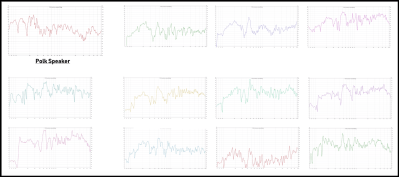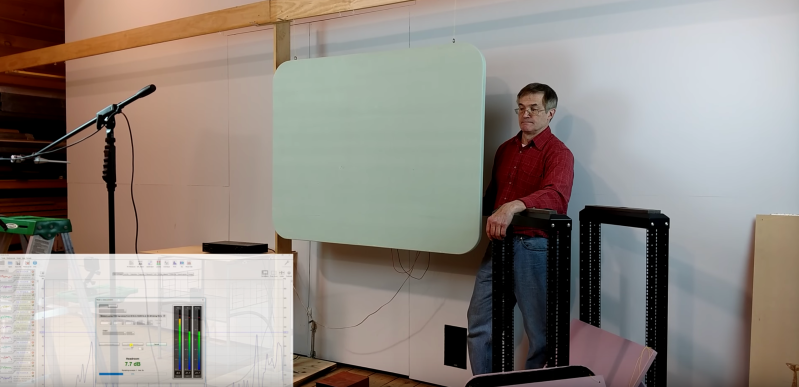Flat panel speakers are heavily reliant on the material they’re mounted on for the best acoustic quality. In particular, for DML (distributed mode loudspeaker) speakers, sound is produced through the distribution of vibration modes in the panel. You can easily spend far too much on special exciter foam or optimized materials for producing the best quality sound.
[Tech Ingredients] does a deep dive into how to build high-quality and low-cost DML speakers using some interesting materials, such as acoustic ceiling tiles and styrofoam. He analyzes their frequency based on the material and shape used and demonstrates how a full setup sounds with studio microphones and stereo speakers installed. The shapes can allow the resonances for different speakers to be translated so that they don’t overlap – peaks can be matched with troughs to produce a more even sound. Squares with rounded edges work the best for translating the resonance.

Balsa wood is mainly used for low frequencies and styrofoam for high frequencies, although the ceiling tiles work as well as either material and are significantly cheaper. Rather than retrofitting into drop ceiling metal frames, he instead installs his panels vertically. He shows the process for preparing the styrofoam and ceiling tiles for hanging, including tips for creating a makeshift circular saw for punching out holes and securing cotter pins with epoxy.
[Tech Ingredients] goes through experimenting with unusual shape and material combinations in order to produce the best possible speakers. It’s a fascinating video that walks through the ins and outs of DIYing your own set of speakers, and it’s worth a watch even just to hear about the acoustic properties of materials.
[Ed Note: Yes, this video is a bit long in the tooth, but we keep getting tips for it, so it’s news to someone! And it’s cool regardless. But feel free to skip on if you’ve seen this one before.]
[Thanks Digital Corpus for the tip!]

















It seems like active eq to counter the panel’s frequency response would be the best way to mitigate the non-uniform response. A cheap DSP like an ADAU1701 would be an ideal choice.. Sigma Studio even has modules for auto-response correction. /shrug
Awesome vid though. Well done research.
I doubt it can do it well, it can’t do fft based filtering so the eq will be coarse.
There is also an issue of the takeoff phase of different frequencies of sound though that medium this appears to be why you carve up the panel to broaden it’s bandwidth and flatten out it’s frequency response.
This is awesome! Definitely making this, guess this is my Halloween project.
I assume you want to go for horrible sound then? Just kidding. Sounds like an interesting concept (no pun intended this time). I work for museums (think interactive installations) and I have used Exciters before to make panels emit sound, so I will definitely look into this further!
This guy sure has a lot of vanity. Worlds best speakers! Perhaps it’s in the eye of the beholder. Certainly don’t share his opinion.
But it’s an interesting take on messing about with audio which is always fun.
Check out his horn speaker builds. They’re the opposite of simple, but incredibly engineered.
Vanity or marketing skills? Would a more honest title attract as many views and earn as much money?
He didn’t state what the speakers are best at. They can be the world’s best speakers for making people want to build them.
Your missing the qualifier. His claim is “worlds best speakers…for less than $115 dollars.” But yeah he put the qualifier in much smaller text lol.
You can hear the echo and standing waves when he speaks in that room. His testing is flawed from the start. He can not really tell the speakers from the room.
Interesting thought though, and I would use pink noise instead of sweeps, but if you tried enough speakers in a room at some point in time you would start to see similar trends in all of them that would be room effects.
Ha indeed, all his ‘world best speakers’ videos are so flawed (measurementwise, theorywise, electroacousticwise) it makes me cringe as an audio engineer. True DML is theoretically interesting but I never heard a good practical example that sounds better than your off the shelve cheap ass hifi speakers. Also, I built several DMLs in the far far past in aim to maximize performance for a project relying solely on portable battery powered speakers (styrofoam actually sounded optimal to me)
Not that I doubt you, but could you list your gripes with the videos on speaker design? As entirely the wrong type of engineer I don’t know where to start with speaker design. I thought the videos were very accessible.
I’ve build the styrofoam panel speakers he described and measured them in the room they hang in and used the measurement to calculate an eq that is imported into a miniDSP 2×4 HD. The result is a prety flat curve with really clean and wide sounding speakers. The attack on them is insane, the details you hear are awesome, escpecially in high end. Plus they really fill a room and they don’t sound a lot different when you don’t stand right in front of them. It was well worth the effort and the money.
I’m planning to do this as a diy project, but i have nore idea how can I work with the eq’s and dsp. Do you have any guide about it?
Use REW (Room equalization wizard) to measure. Make sure you get a calibrated mic, dayton audio sells a cheap one for about 30 euros. Then you can use rew to calculate an eq. I think they have a guide on their website.
Exactly my sentiments. They are a very fun piece. Everyone I’ve shown has giggled in surprise :)
When all is said and done, there are other factors at work here…Is the sound pleasing ? Is it loud enough ? is it cheap to manufacture if you live in a 3rd world country and are strapped for cash ? is it fun to experiment with ? All I see is a bunch of stuffed shirts who probably work for high end audio companies or have enough cash to buy whatever they want. Stop your Audiophile elitism and just for once let people enjoy instead of shitting on every single spec and spychobabble term under the sun.
I spent a couple of nights making some out of foamular 500. Painted them with Gorilla white glue black chalk paint and water mixed in thirds, 2 coats, then three coats of Appliance epoxy that I sprayed then rolled with dry roller. On the last coat I pressed the panel’s into the back side of a light diffuser to perforate them thinking that perhaps more surface area would make them move more air. The theory is correct I just don’t have any others to rest aganst. They sound better every day as the epoxy continues to cure. They are clearer and louder than both pairs of my M Audio and Presonus monitors put together using less than half the power. When I presented them to my boss they filled the complete first floor of the parking garage with music through the open door of the room I was testing them in. BUT. I’ll have to add a tweeter close to he mounting point to reach up into the high frequency range and for two panels that are 18 by 24″ at least one good 6.5 sub is needed. This set is for my Boss for his BD and my first undertaking. My next set will each have their own sub enclosure. I’m hooked on these and will be making many more. Most likely hybrids.
What did mixing in the chalk paint do for that step since you paint over it at the end? I’m noting your process, as well as others. I’m trying to figure what affects sound the most: size, mass, or rigidity. I suppose it’s a combination and what frequency range your going for.
https://www.daytonaudio.com/topic/excitersbuyerguide
Check out the “ideal” section and notice “reinforced” is mentioned several times. That is what your process did, and I’m guessing why it keeps sounding better as it cures. So let’s imagine: the sound waves easily disperse through the foam, then act on the hard layer much like a traditional woofer cone. Makes sense in my head anyway. Lol
+1.
To add to the list of other factors: I wouldn’t assume everyone prioritizes fidelity or accuracy in their evaluation of a good speaker; I sometimes think of them as instruments of sorts, having a character and a unique sound. I suppose the same could be said of some tube amps…
I’ve been meaning to mess around with some panels; I used to make surfboards out of balsa, polystyrene foam and fiberglass “out in the shed” and still have a box full of balsa sheets. Model and RC airplane suppliers can be a good source of balsa… I’ll probably get to it here in the next decade or two.
I wonder if luann would work in lieu of balsa. The stuff used for vinyl floor underlayment. Buy in 4X8 sheet at Lowes or Home Depot.
This same concept has been used on aircraft recently to hide the speakers and has resulted in surprisingly high quality audio with a relatively flat response. It does require special processing unique to the aircraft though.
with the balsa panel, did you glue the individual block together?
You buy them like that:
https://www.amazon.com/Grain-Core-Uncoated-CoreLite-sheets/dp/B07CYMB2BQ
Continental have done this with car interiors recently
https://www.continental.com/en/products-and-innovation/innovation/infotainment-in-the-car/best-sound-without-speakers-119852
Hey great ideas, What i was wondering could the board be cut into a decorative shape with say holes through it like a flower. Or would this reduce the quality?
I’m amazed at how many youtubers are compelled to recreate the same Tech Ingredients project with the same material and dimensions. There has to be 50 different videos all doing exactly the same thing. I like Kody’s idea of cutting holes into the substrate, you never know, it could sound heaps better. There’s a few people that have broken the mould and created something completely different and that’s great to see but I’m a little disappointed to see yet another monitised video showing nothing new. We need to get creative and break new ground in this field, it can go in so many different directions.
Circular, square and rectangular panels seem designed to encourage unwanted resonances. Before I reinvent the wheel, has anyone tried panels with non parallel and unequal length sides? My gut says to me, “use prime number ratios to the side lengths” but my brain says, “Why?”
The exciter placement on the panels is staggered. If I remember correctly, that has to do with the frequency of the panels not conflicting with each other. For altering panel frequency, it seems overall size and density has most effect; with people applying stiffener of some sort. Glue being a common one. From what I have gathered , there really isn’t a cohesive body of information for DML speakers that says “Do this to get that”. Normal drivers have graphs, box alignment suggestions, and crossover point. Not so with exciters. Check out the section on Parts Express to see what I mean. https://www.parts-express.com/resources-buyers-guide-exciters
Basically it says to experiment.
Your idea would alter the rate at which the sound waves reach the edges of the panel. You would need make a standard shape panel, make your idea, and compare.
I have built box speakers, not dml yet. I’m not interested in “it sounds good for what it is”.
Good luck. Share your findings if you do it.